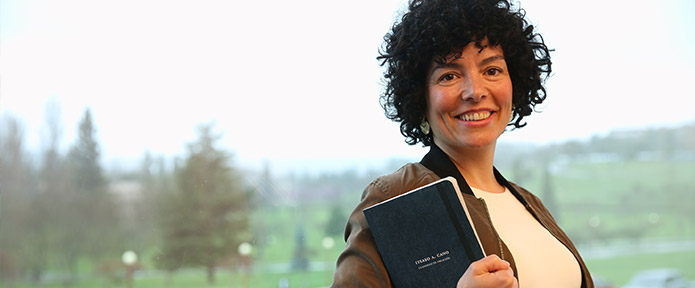20200305_MUN_PresentationCreativeBookletItsasoCano
The choreographer and dancer Itsaso A. Cano presents 'notebook de creación' at the MUN, a journey into the back room of her creative universe.
The book, published by the Museum of the University of Navarra, gathers the creative process of the artist that culminated with the premiere of the show 'subject'.

The Navarrese choreographer and dancer Itsaso A. Cano used to write down in a notebook of yellowed and worn-out sheets every idea and sketch of subjectthe choreography that culminated during the artistic residency program she made at the Museo Universidad de Navarra. This notebook was the starting point for Itsaso A. Cano. Cano. notebook de creación, the book that opens the doors to the creative universe of the artist.
The work was presented this Thursday at a meeting with the participation of the choreographer herself; José Manuel Garrido, director artistic of Performing Arts and Music of the Museum; and Ibis Albizu, editor of the volume. Published by the Museum, it has been supported by high school Nacional de las Artes Escénicas y de la Música (INAEM), Fundación Caja Navarra and Obra Social LaCaixa. This is the second volume of this collection, directed by Garrido, which began with the one dedicated to the choreographer and dancer Javier Martín.
One of the aspects that characterize this collection is that it paves the way for the publication of works on contemporary dance in Spain. "There is no bibliography. Only a few books translated from English. It is a vast desert. Contemporary dance is still to be written, even to be known. And this collection is a great contribution," says the choreographer.
In this sense, it also fits in with the DNA of the Museum, which since its inception has been strongly committed to this discipline. "We have developed an artistic speech related to dance in all its registers, both in the theater and in other spaces of the Museum," explains José Manuel Garrido. Thus, this collection "gives a seal of particularity and demonstrates the personality of the Museum, which explores the conjunction of the arts, dance in permanent dialogue with plastic works".
BONE, MUSCLE AND SKIN
Through Itsaso A. Cano. notebook de creación, which gathers texts, photographs, sketches and annotations, conceived as a field notebook , Cano approaches her way of working, orderly, creative and guided by intuition. "I look for an emotional understanding. It is a dance that appeals to the body, to the bones and muscles. It is interesting that when you go to see a work, something in you is impregnated and transforms you in some way. Everyone can make a reading from the moment they are in."
In this sense, Albizu stressed that "it is very difficult to write a choreography because of the ephemeral nature of dance, something that does not happen with music or theater. This book, with a very careful edition, allows us to access these secrets often so well kept by choreographers". It also allows us to know how the artist works, who "is very methodical, even though she tries to transmit emotional atmospheres".
In this publication, we access the behind-the-scenes of subject, whose absolute premiere took place in November 2018, in the cycle Museo en Danza, at position of her company, Zuk Performing Arts. And this approach, explains the editor, is done in three layers: "They are a metaphor of the subject from which we are formed. The first, the bone, refers to the concepts, what readings a choreographer makes to gestate a work, how he thinks about it. The second is the muscles, what drives them. They are the scenes and what they tell. And the last one, the skin, what envelops everything else. They are the equipment, the dancers, the musicians, the costumes, the lighting...".
The challenge was how to bring to the pages the essence of each choreographic scene, in Cano's words: "We went, little by little, simplifying until we chose a single element. For example, there is a scene in which the dancers are tied with ropes and we decided to choose a photograph of a rope and a small phrase to approach what it meant to us".

